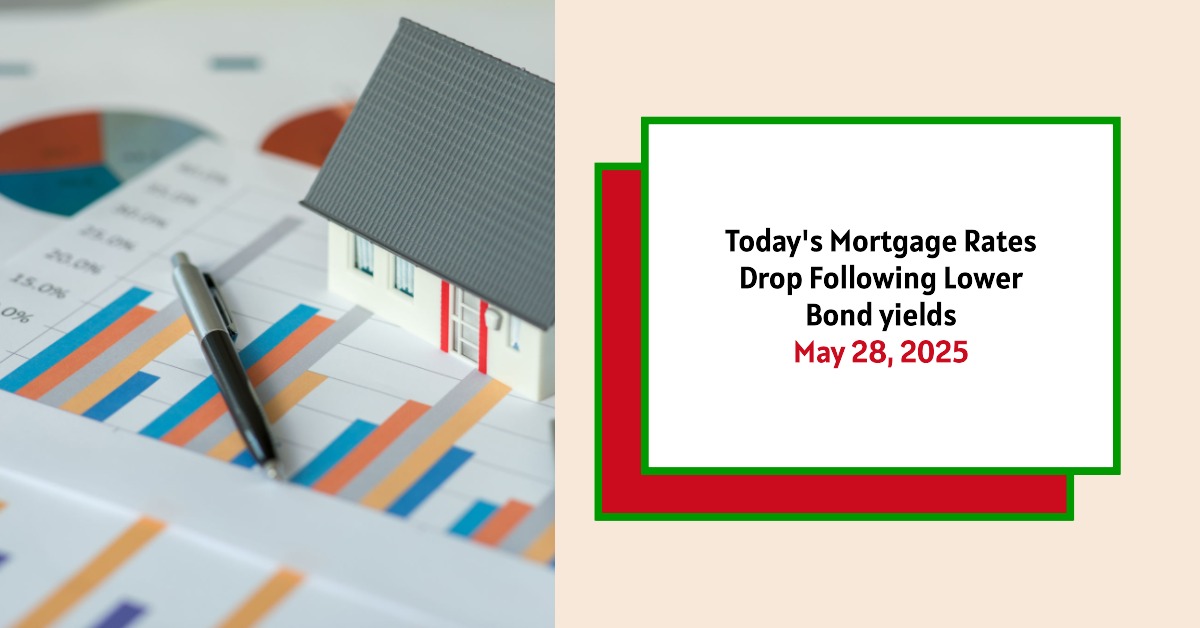As of today, May 28, 2025, mortgage rates have seen a slight decrease across most loan terms, providing a more favorable environment for potential homebuyers and those considering refinancing their current mortgages. The average 30-year fixed mortgage rate is now 6.86%, which is a positive shift from previous highs that nearly approached 7%. Similarly, the 20-year rates have settled at 6.61%, and the 15-year rates have slipped down to 6.06%. This decline is a welcome change, especially for buyers who have been navigating a fluctuating market.
Today's Mortgage & Refinance Rates – May 28, 2025: Rates Drop Following Lower Bond yields
Key Takeaways:
- Mortgage Rates have dropped across popular loan terms.
- The average rate for a 30-year mortgage is now 6.86%.
- Refinance Rates are also lower: 30-year fixed at 6.96%.
- Economic factors, including tariff discussions and inflation, are influencing rate changes.
- Market Predictions indicate a cautious outlook for future rate moves.
Current Mortgage Rates – May 28, 2025
Based on the latest data reported by Zillow, here are the current mortgage rates:
| Loan Type | Current Rate (%) |
|---|---|
| 30-Year Fixed | 6.86 |
| 20-Year Fixed | 6.61 |
| 15-Year Fixed | 6.06 |
| 5/1 Adjustable Rate Mortgage (ARM) | 7.04 |
| 7/1 ARM | 6.73 |
| 30-Year VA | 6.39 |
| 15-Year VA | 5.76 |
| 5/1 VA | 6.42 |
These rates represent national averages and are rounded to the nearest hundredth. Individual rates may vary based on credit scores, down payment size, and market conditions.
Today's Refinance Rates
For homeowners looking to refinance, the following rates are available as of May 28, 2025:
| Loan Type | Refinance Rate (%) |
|---|---|
| 30-Year Fixed | 6.96 |
| 20-Year Fixed | 6.80 |
| 15-Year Fixed | 6.21 |
| 5/1 ARM | 7.33 |
| 7/1 ARM | 6.72 |
| 30-Year VA | 6.41 |
| 15-Year VA | 5.91 |
| 5/1 VA | 6.22 |
Typically, refinancing rates are slightly higher than purchase rates due to the additional risks that lenders assume. This difference underscores the importance of assessing your financial situation and how long you plan to stay in your home before making a decision to refinance.
Understanding Mortgage Rates and Their Influences
Mortgage rates are influenced by several economic factors, including:
- Bond Yields: When government bond yields decline, mortgage rates typically follow suit. The current drop in yields has been significant, encouraging lenders to lower borrowing costs for homeowners.
- Inflation: The ongoing discussions about inflation have created uncertainty in financial markets. With tariffs potentially raising consumer prices, inflation indicators continue to fluctuate, complicating predictions for future mortgage rates.
- Federal Reserve Policies: The actions taken by the Federal Reserve heavily influence mortgage rates, despite the rates not being directly tied to the federal funds rate. After several increases in 2022 and 2023, the Fed has recently adjusted its stance in response to evolving economic conditions, impacting how lenders set rates.
As of today, the Fed has lowered its expectations regarding rate hikes, which has contributed to the current drop in mortgage rates. Homebuyers and those refinancing should remain vigilant about any monetary policy changes that may arise, as future adjustments can have immediate ramifications on their borrowing costs.
Historic Context
Understanding how current rates compare to historical trends is essential for potential homeowners. In 2020 and 2021, mortgage rates hit unprecedented lows, dipping below 3% at times. Today’s rate of 6.86% is markedly higher, yet it represents a step down from the highs experienced earlier this year, particularly when rates nearly hit 7% in January.
It's imperative for buyers to keep in mind the historical context of rates. While 6.86% may seem high compared to the extraordinary lows of the pandemic years, it is still comparatively lower than the averages of previous decades when rates were routinely above 7% and often higher, peaking at over 18% in the early 1980s.
Pros and Cons of Different Mortgage Types
30-Year Fixed Mortgage:
- Pros:
- Lower Monthly Payments: Spreading payments over 30 years makes them more manageable.
- Predictability: You know your monthly payments won't change, which can help with budgeting.
- Cons:
- Higher Interest Paid: Paying for 30 years typically results in much more paid in interest over the life of the loan.
- Slower Equity Build-Up: With lower payments, it takes longer to build equity in your home compared to shorter terms.
15-Year Fixed Mortgage:
- Pros:
- Lower Interest Rate: Generally, you will lock in a lower interest rate compared to a 30-year mortgage.
- Faster Equity Accumulation: Homeowners build equity quicker, which can be advantageous if they choose to sell.
- Cons:
- Higher Monthly Payments: Since the loan term is shorter, your monthly payments will be significantly higher.
- Less Financial Flexibility: Higher payments can limit your budget for other expenses.
Adjustable-Rate Mortgages (ARMs):
- Pros:
- Lower Initial Rates: ARMs often start with a lower interest rate, leading to lower initial monthly payments.
- Potential for Decreasing Rates: If interest rates fall after the fixed period, borrowers may benefit from lower payments.
- Cons:
- Rate Increases After Initial Period: Once the fixed period ends, rates can increase, potentially leading to higher payments.
- Risk of Uncertainty: Future payments can be unpredictable, making budgeting more challenging.
Read More:
Mortgage Rates Trends as of May 27, 2025
Dave Ramsey Predicts Mortgage Rates Will Probably Drop Soon in 2025
The Future of Mortgage Rates
Looking forward, the outlook for mortgage rates remains cautious, rooted in the broader economic environment. With inflation concerns and potential economic slowdowns looming, rates could experience significant fluctuations in the coming months. Experts predict that mortgage rates may dip slightly in the latter half of 2025, but not substantially enough to return to the historically low levels seen during the pandemic.
Market forecasts suggest that if inflation continues to tick upward, mortgage rates could either stabilize or further increase. For homebuyers, this means being prepared for ongoing changes and actively monitoring the economic indicators that may influence their purchasing power.
Summary
The mortgage landscape as of May 28, 2025, reflects the intertwined nature of economic sentiment, federal policy, and market expectations. Today’s lower rates offer an encouraging sign for homebuyers and those considering refinancing, yet the underlying economic factors suggest that vigilance is essential. As we navigate these changes, staying informed about market conditions, talking with lenders, and carefully evaluating personal financial situations will be crucial for anyone looking to make significant housing decisions.
Invest Smarter in a High-Rate Environment
With mortgage rates remaining elevated this year, it's more important than ever to focus on cash-flowing investment properties in strong rental markets.
Norada helps investors like you identify turnkey real estate deals that deliver predictable returns—even when borrowing costs are high.
HOT NEW LISTINGS JUST ADDED!
Connect with a Norada investment counselor today (No Obligation):
(800) 611-3060
Also Read:
- Will Mortgage Rates Go Down in 2025: Morgan Stanley's Forecast
- Expect High Mortgage Rates Until 2026: Fannie Mae's 2-Year Forecast
- Mortgage Rate Predictions 2025 from 4 Leading Housing Experts
- Mortgage Rates Forecast for the Next 3 Years: 2025 to 2027
- 30-Year Mortgage Rate Forecast for the Next 5 Years
- 15-Year Mortgage Rate Forecast for the Next 5 Years
- Why Are Mortgage Rates Going Up in 2025: Will Rates Drop?
- Why Are Mortgage Rates So High and Predictions for 2025
- Will Mortgage Rates Ever Be 3% Again in the Future?
- Mortgage Rates Predictions for Next 2 Years
- Mortgage Rate Predictions for Next 5 Years
- Mortgage Rate Predictions: Why 2% and 3% Rates are Out of Reach
- How Lower Mortgage Rates Can Save You Thousands?
- How to Get a Low Mortgage Interest Rate?
- Will Mortgage Rates Ever Be 4% Again?


